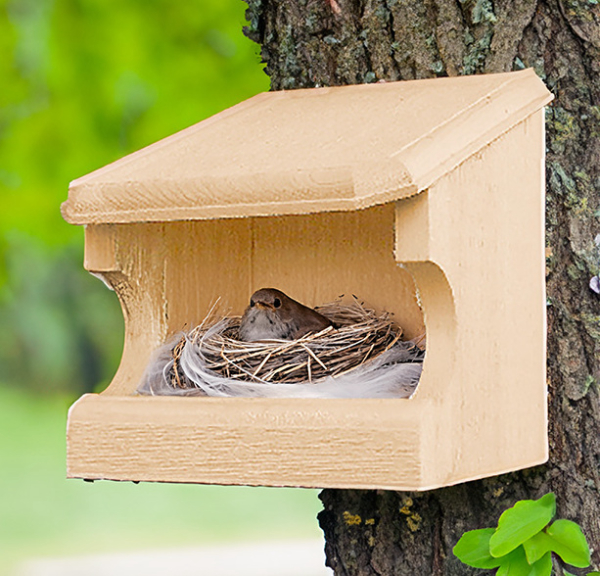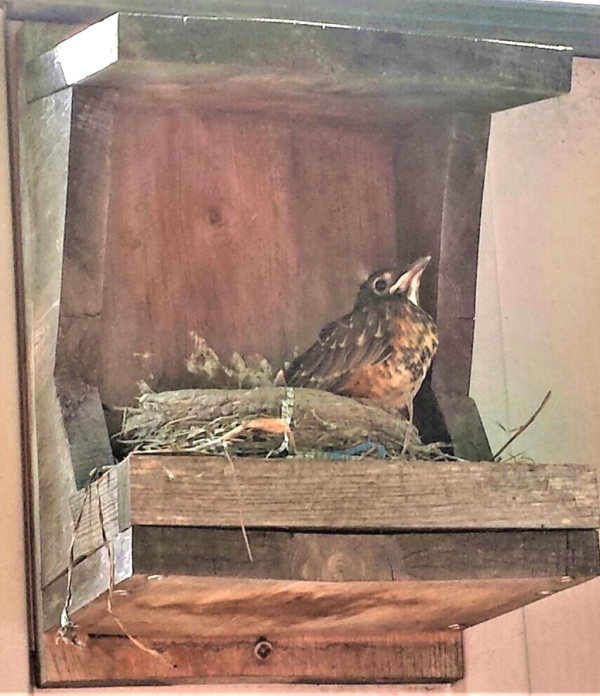
A good example of a nest shelf used by robins, phoebes, and other birds is available at BestNest.

With its nestmates already fledged, a soon-to-fledge young American Robin remains in a nest shelf provided by an enthusiastic birder.
|
Providing a “nest shelf” can be a way to invite some favorite birds to your yard, namely American Robins, plus Eastern Phoebes or Say’s Phoebes. These interesting birds can be attracted by providing a nest shelf, and there is a potential for Mourning Doves or House Finches to use a shelf too. You can also use a nesting shelf to re-direct these birds to a location where you would prefer them to locate their nest, and where you can observe their nesting activities better.
You may already be familiar with some of these birds nesting on the edge or corner of a building in your yard or neighborhood where they build a nest in a location that offers a degree of protection and stability for the nest. A nest shelf will provide even more protection and nest stability for robins, phoebes, or other birds to build their nest in. To attract “shelf-nesting” birds, or to redirect them to a certain location, some years ago a creative birder tried building a simple shelf that proved to be used by nesting robins, and over the years the design has been improved.
A nest shelf tends to have an open-ended box shape, but the best ones are more open on the side panels so the adult birds can see more of the surrounding area while incubating or brooding. Nest shelves have a slanted roof with a bit of an overhang to protect the nest and birds from the elements, and a drain hole in each corner of the floor. They also have a low support edge on the front to help contain the nest and its contents within the shelf.
It’s important to position a nest shelf where you have a good view of it; after all, part of the fun is observing the birds’ nesting activities during the nesting process. But you can also install a nest shelf on the top of a post or pole that has a predator guard below the shelf – just as you would install a nest box. Adding a predator guard is especially important to ensure the nest shelf is safe for birds to use. Providing a safe place to nest is even more important than providing a nest shelf in the first place, because we don’t want to endanger an incubating adult, its eggs or nestlings.
Another important consideration is that birds that use nest shelves tend to re-nest after their first nesting attempt, after their nestlings have fledged. That’s when you should remove the previous nest to make the nesting shelf available for the pair’s second or even third nesting cycle. The act of building a nest is an important part of the behavioral and physiological cycles that preclude egg development, and only rarely will the birds build on top of or beside a previous nest. So don’t hesitate to remove the nest after nestlings have fledged, it’s actually beneficial. Plus, you may get to experience another nesting cycle, possibly by the same pair, but maybe by a second species during the same nesting season – you never know.
Building or Buying a Nest Shelf
Making a nest shelf is easy, and it’s something you can share with children or build on your own. You can get Free plans to build a nest shelf for robins at American Robin - NestWatch or Eastern Phoebes at Eastern Phoebe - NestWatch. It turns out that Say’s Phoebes and Black Phoebes might be less apt to use a nest shelf, but in case you would like to try, see Say's Phoebe - NestWatch. You can also make a predator guard by covering the post or pole that you attach your nest shelf to with a 3 foot length of metal stove pipe to keep raccoons, snakes, and squirrels from climbing to the nest; see (nestboxplans (nestwatch.org)).
If you prefer to buy a nest shelf, the best one we’ve seen that features partly open sides is available from BestNest at Coveside Open Nest Box at BestNest.com. BestNest also has predator guards available at Lonestar Predator Guard, Gray, 7" dia. at BestNest.com
This is also a good time to make the point that when we attract birds to our yards, we need to be especially careful not to use pesticides and fertilizers that may affect the birds we wish to benefit, or the earthworms and insects the birds eat and feed their nestlings. Environmental health is all interconnected, and by making areas better for birds, we simultaneously make them better for our yards, our families, and our pets. Enjoy this spring more than ever as birds begin this nesting season; let’s make it a year to remember and celebrate.
Share your backyard birding experiences and photographs with The Birding Wire at editorstbw2@gmail.com